How To Make Basil Pesto Without Cheese (Dairy-Free Recipe)
Looking for a delicious, dairy-free pesto recipe? This plant-based pesto uses nutritional yeast for a cheesy, umami flavour, lemon juice for acidity, and loads of fresh basil. Vegan pesto sauce is perfect for pasta, sandwiches, or even as a dip.
Just because you prefer things plant-based doesn’t mean you have to compromise on flavour! This simple vegan pesto without cheese is a delicious dairy-free pesto sauce that turns any salad or pasta dish into a flavourful and satisfying meal.
As a bonus, pesto without cheese freezes exceptionally well. And, this freezer-friendly pesto sauce is a great way to use up large amounts of fresh basil leaves while they are abundant in summer.
Homemade basil pesto trumps the store-bought pesto every time. And with this super easy vegan pesto recipe, you have no excuse not to give it a try!
If you prefer your pesto with cheese, try my large batch food processor pesto or traditional pesto alla Genovese instead.
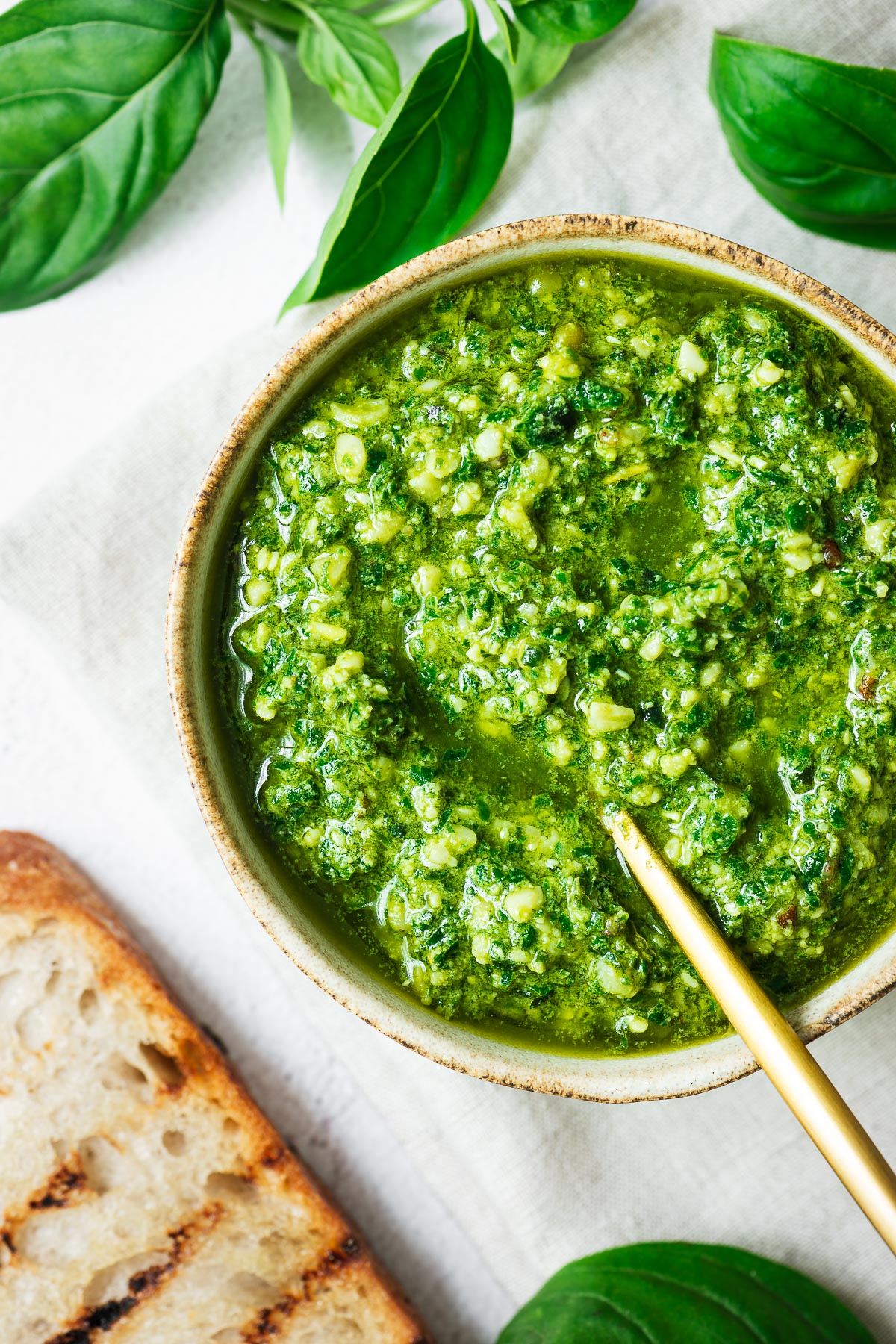
Ingredients and substitutions
Traditional Italian pesto relies on freshly grated parmesan cheese for its salty, nutty flavour and natural acidity.
To make pesto without cheese, we replace these flavours with fresh lemon and nutritional yeast in this dairy-free pesto recipe.
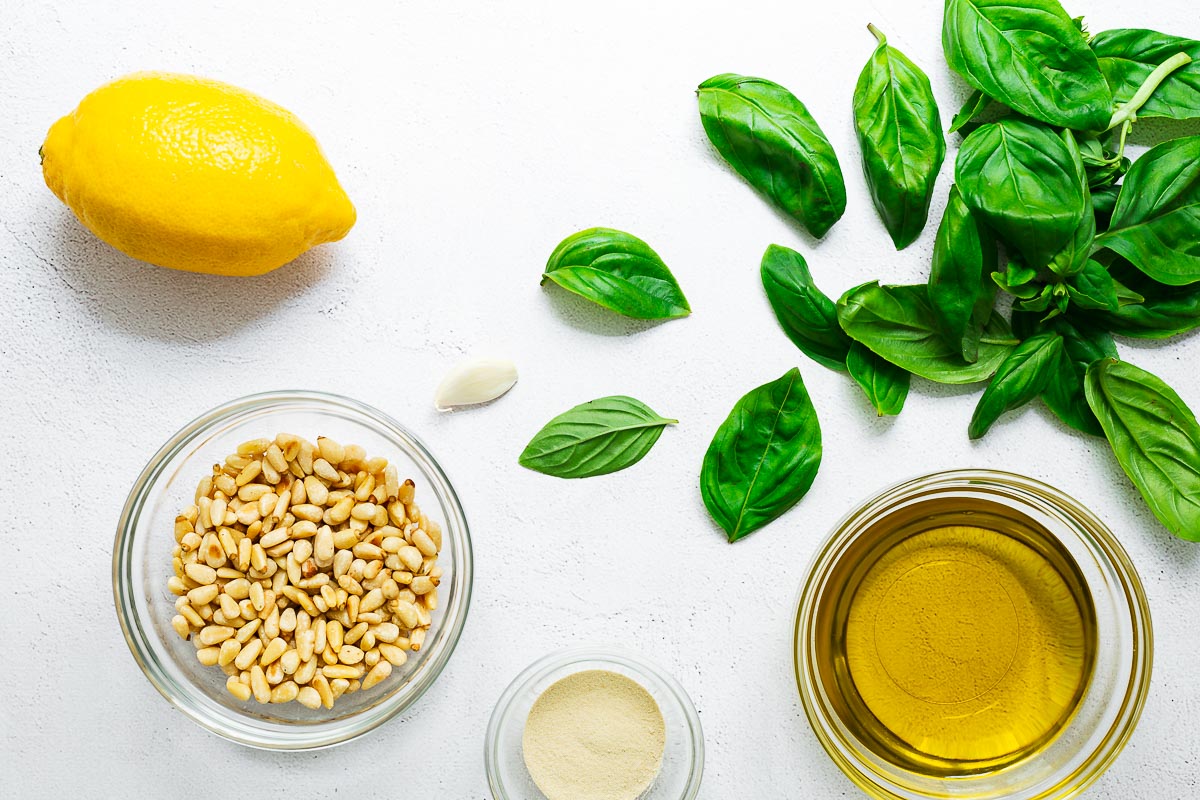
You still only need a handful of simple ingredients for the best vegan pesto sauce:
- Basil: Fresh basil leaves are the main ingredient in this vegan version of traditional basil pesto. But you can make pesto from other fresh herbs or leafy greens, like arugula or kale.
- Pine nuts: Don’t skimp on your nuts when making this dairy-free version. It creates a creamy texture and nutty flavour that balances the fresh, green basil flavour. You can also try cashew nuts, pumpkin seeds (pepitas), or sunflower seeds, or another substitute for pine nuts in pesto if you prefer pesto without pine nuts.
- Olive oil: Use good quality extra virgin olive oil. It is a big part of the Italian flavour profile in this delicious pesto.
- Garlic cloves: Use fresh garlic cloves or substitute with roasted garlic or, in a pinch, try half a teaspoon of garlic powder. You can omit the garlic if you prefer but don’t use store-bought minced garlic.
- Lemon juice: The perfect pesto flavour is a balance of the herbaceous basil flavour, fat, salt and acidity (traditionally from cheese). I love a squeeze of fresh lemon juice for acidity, but you can use a splash of apple cider vinegar if that is what you have. Add lemon zest if you want more prominent citrus flavours.
- Nutritional yeast: Use nutritional yeast flakes or powder for a cheesy flavour. But this is optional. The vibrant pesto is utterly delicious, with or without the nutritional yeast.
Related post: Best substitute for pine nuts in pesto
How to make plant-based basil pesto without cheese
Traditional pesto is made by pounding fresh basil leaves in a mortar. In Italian, the word pesto means “pounded”.
This authentic Italian method certainly makes the best pesto. And while it’s great for small batches of pesto, who has the time (and arm strength) to bound a mountain of fresh basil leaves into a smooth paste?
Well, not me, that’s for sure!
Instead, I opt for a hybrid method where we pound the garlic and pine nuts into a creamy paste before processing the basil leaves in a large food processor! (But I also give instructions if you prefer to do this in a food processor.)
This delicious basil pesto sauce comes together in minutes. So, grab your mountain of basil leaves and let’s make some vegan basil pesto sauce!
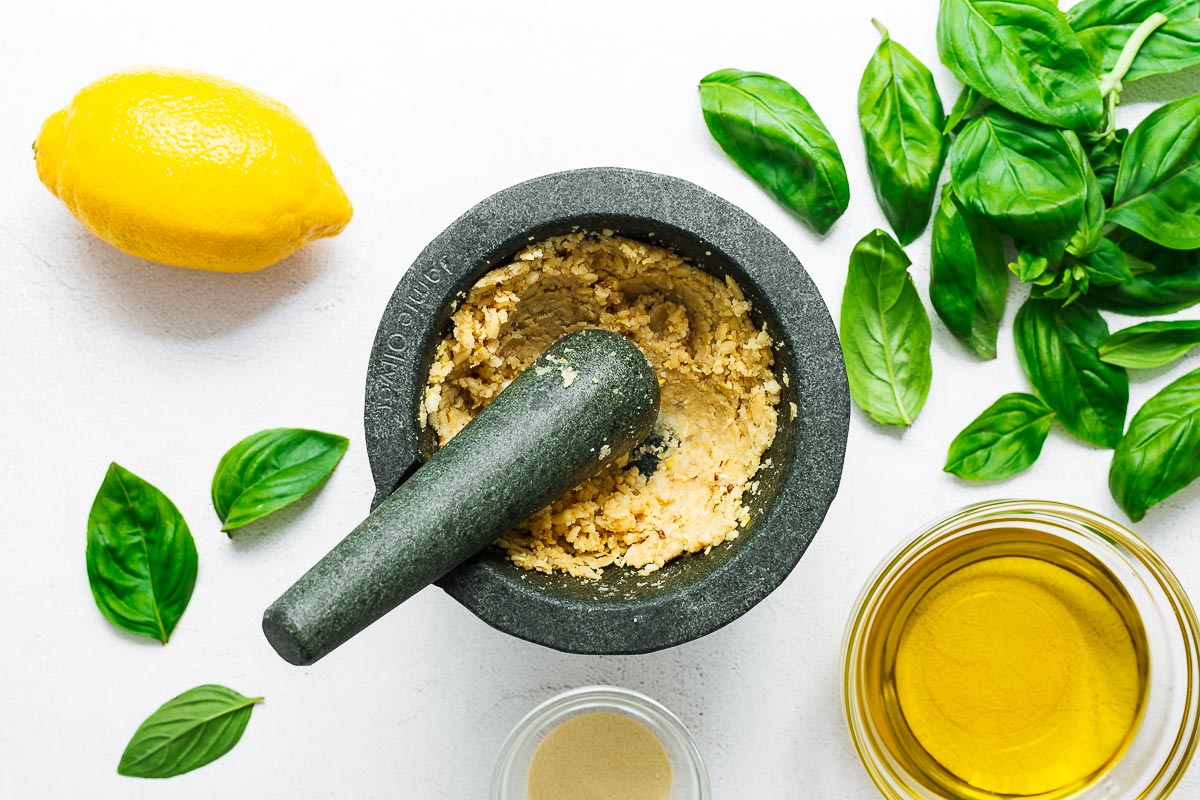
Step 1: Pound garlic and pine nuts into a paste
Place the roughly chopped garlic clove in a mortar with half a teaspoon of salt. Coarse sea salt works best, but you can also use kosher salt.
Grind the garlic into a paste with the pestle.
Then add the toasted pine nuts and bash them into a paste. It will be a thick paste with a creamy texture. Don’t worry if there are still a few pieces of nuts visible.
Don’t have a mortar and pestle? You can skip this step and add the garlic and nuts to the food processor before the basil leaves. Pulse the garlic and pine nuts into a smooth and creamy paste with half the olive oil.
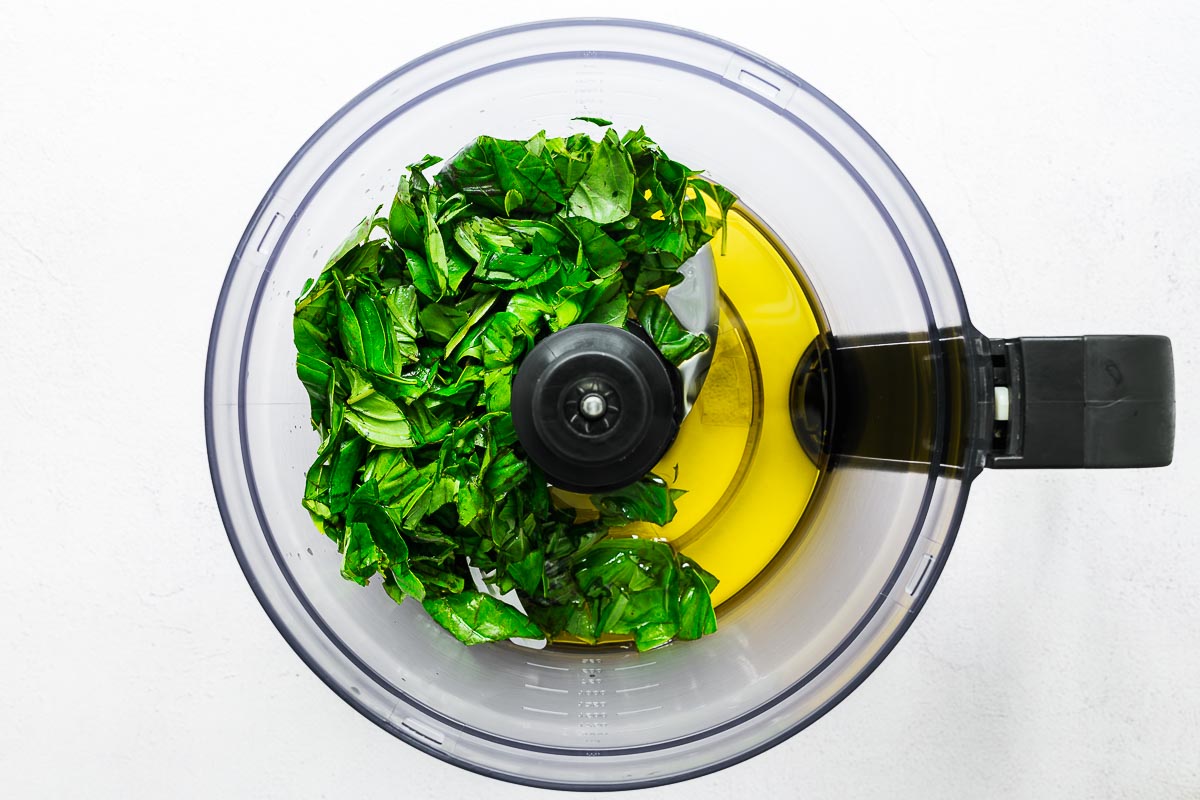
Step 2: Process the fresh basil leaves
The key to making classic pesto in a food processor is to avoid over-processing. The heat generated by the motor, along with oxidation from over-chopping, can cause the basil to turn brown.
Roughly slice the basil leaves, add them to the food processor bowl, then pour half the olive oil over the leaves.
Pulse the basil leaves in the food processor. Stop to push down the leaves with a spatula a couple of times. And keep going until you have a coarse, bright green basil paste. It should take a minute or so.

Step 3: Mix the basil pesto
Transfer the basil paste to a bowl, stir through the remaining olive oil and add the salty garlic and pine nut paste (if you didn’t process it in the food processor).
Mix in the lemon juice and nutritional yeast.
Taste and adjust the salt and acidity. Add more olive oil until you reach your desired consistency.
Transfer the pesto to an airtight container or glass jar and cover it with a thin layer of olive oil. You can store pesto in the fridge for three to four days.
How to freeze fresh basil pesto without cheese
You can place pesto in a freezer-proof airtight container and freeze it for up to three months.
But, I prefer to freeze the pesto in ice cube trays. It also works great for small amounts of leftover pesto.
Transfer the pesto to an ice cube tray and freeze it until solid. Then transfer the pesto cubes to a freezer bag (reusable silicone or Ziploc bag). Squeeze as much air as possible from the freezer bag.
Defrost your pesto cubes as needed.
When I make a large batch of basil pesto for freezing, I leave the lemon juice and the nutritional yeast. Then, when I defrost the pesto, I add fresh lemon juice, more olive oil and nutritional yeast to taste.
Serving suggestion
Pesto is a versatile condiment. It’s a great sauce to make in the summer months when fresh basil is available in abundance.
- Pesto pasta sauce: Add your green pesto to a large bowl and toss it with cooked pasta for a vegan pesto pasta dinner. Thin with pasta cooking water if needed, drizzle with olive oil and garnish with fresh basil leaves. You can also try this with zucchini noodles!
- Pesto salad dressing: Pesto is a delicious salad dressing. Mix it with olive oil and lemon juice to taste and drizzle over chopped salads. It’s also delicious in a tomato salad!
- Pesto potato salad: Basil pesto is also delicious in potato salad. Skip the chopped herbs and add a quarter cup of fresh pesto to this vegan herbed potato salad.
- Pesto pizza: Drizzle homemade pesto over cooked pesto or flatbread for an instant flavour boost that the whole family will love.
- Pesto soup: Add instant freshness to your favourite vegetable soup by drizzling it with pesto. Try it with this easy red lentil soup or broccoli, basil, and pea soup!
Homemade pesto is also delicious tossed with roasted vegetables, used as a sandwich spread, or added to pasta salad.
So, what are you waiting for? Make this easy basil pesto recipe without cheese to add fresh flavour to your favourite midweek meals.
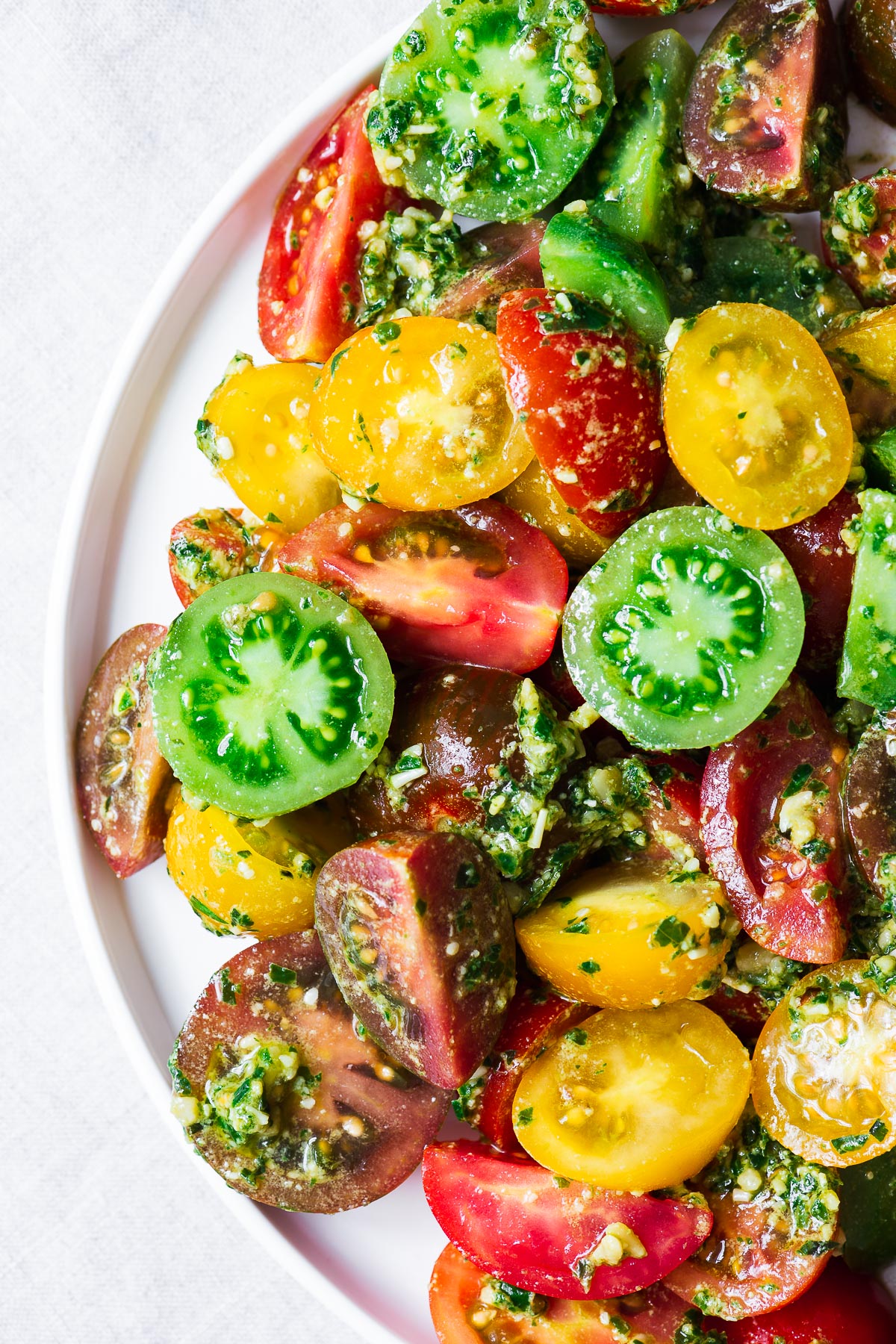
Frequently asked questions
In traditional pesto, cheese adds a rich and creamy texture and salty, umami flavour. However, if you want a plant-based pesto without cheese, you can use nutritional yeast and lemon juice for a dairy-free cheesy flavour.
Traditional pesto alla Genovese contains cheese, but you can leave the cheese out of your pesto. While cheese adds a certain creaminess and flavour to pesto, it is not a necessary ingredient. You can still enjoy a delicious and flavorful pesto without cheese.
Cheese is a traditional ingredient in pesto, specifically Parmesan or Pecorino Romano. It adds a creamy, salty, umami element to the sauce. However, if you are dairy-free or vegan, you can easily omit the cheese and still have a tasty pesto.
Pesto without cheese freezes well, better than pesto with cheese since the cheese can change in texture when frozen. By freezing your dairy-free pesto, you can extend the freshness to three months!
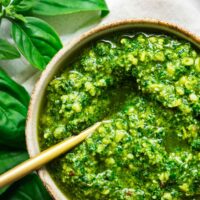
Equipment
- Food processor – see the notes if you don't have one
Ingredients
- 1 garlic clove, roughly chopped
- ½ teaspoon salt, more to taste
- ½ cup pine nuts, lightly toasted*
- ½ cup extra virgin olive oil, more to top
- 2 cups packed fresh basil leaves, roughly chopped
- 1 tablespoon lemon juice
- 1 tablespoon nutritional yeast
Instructions
- Place the roughly chopped garlic clove in a mortar with half a teaspoon of salt. Grind the garlic into a paste. Then add the toasted pine nuts and bash into a creamy paste. (Or process in a food processor with half the oil until you have a creamy paste.)
- Add the chopped basil leaves to a food processor bowl and drizzle with half of the olive oil. Pulse, stopping to push down the leaves with a spatula a couple of times until you have a fragrant, emerald-green basil paste.
- Transfer the basil paste to a bowl with the remaining olive oil, and add the salty garlic and pine nut paste. Mix in the lemon juice and nutritional yeast.
- Taste and adjust the salt and acidity. Keep in mind that the flavours develop as the mixture sits. Add more olive oil for a thinner consistency.
Notes
- Toast raw pine nuts in a hot, dry pan for a few seconds – taking care not to burn them.
- When I plan to freeze basil, I don’t add lemon juice or nutritional yeast. I add it when I defrost the basil pesto for the perfect fresh basil pesto taste. You can also stir in some extra olive oil to revive it a bit.
- See the full blog post for ingredients and substitutes and step-by-step instructions for pesto without cheese.
